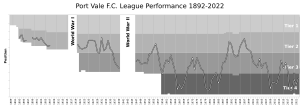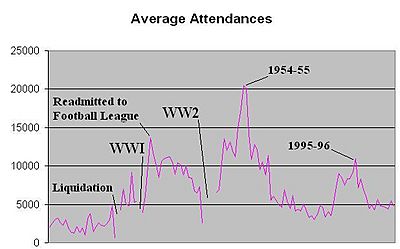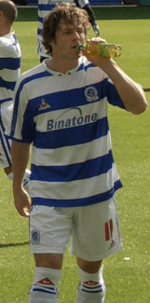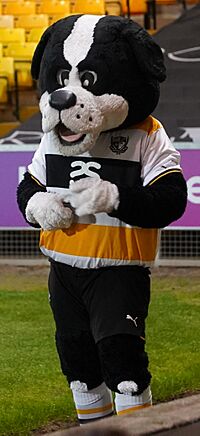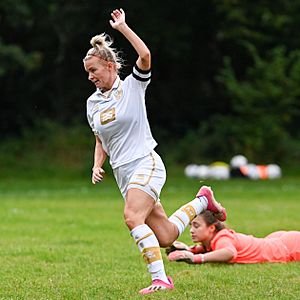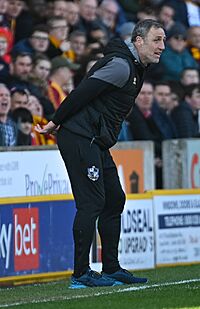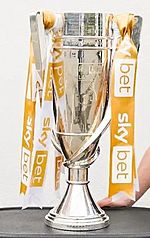Port Vale F.C. facts for kids
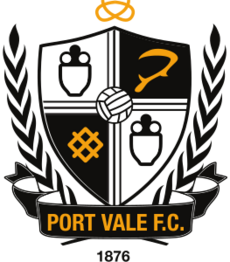 |
|||
| Full name | Port Vale Football Club | ||
|---|---|---|---|
| Nickname(s) | The Valiants | ||
| Short name | Vale, PVFC | ||
| Founded | 1876 (disputed) 1879 (speculated) 1907 (reestablished) |
||
| Ground | Vale Park, Burslem, Stoke-on-Trent | ||
| Capacity | 15,036 | ||
| Coordinates | 53°2′59″N 2°11′33″W / 53.04972°N 2.19250°W | ||
| Owner | Synsol Holdings Limited | ||
| Chairlady | Carol Shanahan | ||
| Manager | Darren Moore | ||
| League | League Two | ||
| 2018–19 | League Two, 20th of 24 | ||
|
|
|||
Port Vale Football Club is a professional football team from Burslem, Stoke-on-Trent, England. They play in League Two, which is the third level of English football. The club got its name from the valley where many canal ports were located on the Trent and Mersey Canal.
Port Vale has never played in the very top league of English football. In fact, they hold the record for playing the most seasons (113) in the English Football League without ever reaching the top division. After playing at different stadiums like the Athletic Ground and the Old Recreation Ground, the club moved back to Burslem when their current home, Vale Park, opened in 1950. Outside Vale Park, there's a statue of Roy Sproson, a legendary player who played 842 games for the club.
The club's biggest rivals are Stoke City. Games between these two teams are known as the Potteries derby.
Port Vale became one of the most important football clubs in Staffordshire. They were invited to be founding members of the Football League Second Division in 1892. They played 13 seasons in this division, with two breaks in the Midland League. In 1907, the club had serious money problems and had to close down.
However, the name Port Vale continued in a smaller league. This new club was so successful that it was allowed back into the Football League in 1919. They spent 16 seasons in the Second Division, winning the Third Division North title in 1929–30. They then dropped back to the third level at the end of the 1935–36 season.
In the 1953–54 season, manager Freddie Steele's strong "Iron Curtain" defence helped them win the Third Division North title. They also reached the semi-finals of the FA Cup. They didn't build on this success, but they did win the first Fourth Division title in 1958–59 under Norman Low.
The club had little success in the 1960s and 1970s. They were even briefly managed by football legend Stanley Matthews. In 1968, they faced trouble for breaking FA rules about player payments. Gordon Lee then led the club to promotion back to the Third Division the next season. They stayed there until they were relegated at the end of the 1977–78 season.
John McGrath guided the club to promotion in 1982–83. His assistant, John Rudge, became the club's longest-serving and most successful manager, leading the team from 1983 to 1999. Under Rudge, Port Vale won promotions in 1985–86, 1988–89, and 1993–94. They also won the Football League Trophy in 1993 and finished eighth in the second division in 1996–97, their best finish since World War II.
After Rudge left, the club struggled and dropped into the fourth division. They faced serious money problems twice, in 2003 and 2012. Manager Micky Adams helped them get promoted from League Two in the 2012–13 season. However, they were relegated back to League Two at the end of the 2016–17 season after trying a new playing style.
Carol Shanahan bought the club in 2019. Manager Darrell Clarke led them to promotion from the League Two play-offs at the end of the 2021–22 season. They were relegated at the end of the 2023–24 season, but secured an immediate promotion under new manager Darren Moore in the 2024–25 season.
Contents
Club History: How Port Vale Started
The club's official story says Port Vale F.C. was formed in 1876. This happened after a meeting at Port Vale House, which is supposedly where the club got its name. However, old records from that time are hard to find. A historian named Jeff Kent believes the club probably started in 1879. He thinks it was a spin-off from Porthill Victoria F.C. and was named after the valley of canal ports where the team played.
In the early days, the team played at Limekiln Lane in Longport. From 1880, they played at Westport. The club moved to Moorland Road in Burslem in 1884. At this time, they changed their name to Burslem Port Vale. They only stayed in Burslem for one year before becoming a professional team. They then moved to Cobridge to play at the Athletic Ground.
In 1892, the club was invited to be a founding member of the Football League Second Division. They had shown they were a strong team in the Midland League. They spent 13 seasons in the Second Division. They also had two seasons back in the Midland League in 1896–97 and 1897–98.
The club had to leave the league at the end of the 1906–07 season. They then officially closed down. However, the name Port Vale continued when a smaller team called Cobridge Church decided to change their name. This new club moved to their new home, the Old Recreation Ground, in Hanley in 1912.
They returned to the Football League in October 1919. They took over the games of Leeds City, who had to stop playing due to money problems. Wilf Kirkham played his first game for Vale in October 1923. Over the next ten years, he scored a club record 164 goals in league and cup games. This included a club record 41 goals in the 1926–27 season.
The club was relegated for the first time at the end of the 1928–29 season. They went from the Second Division to the Third Division North. They won the championship the next season. In the 1930–31 season, they finished fifth in the second level of English football. This was their highest league finish ever. Vale also beat Chesterfield by a club record score of 9–1 on September 24, 1932. However, after these achievements, the club was relegated again in the 1935–36 season. They stayed in the third level until World War II.
Port Vale moved into their new home, Vale Park, in 1950. A year later, Freddie Steele became the club manager. Steele quickly made a name for himself, creating the famous 'Iron Curtain' defence. The 1953–54 season saw Vale win the Third Division North title. They also reached the semi-finals of the FA Cup, losing to West Bromwich Albion. Three years later, the club was relegated again. They became founding members of a new division, the Football League Fourth Division. Manager Norman Low encouraged attacking play. In the 1958–59 season, he led the team to the Fourth Division title, scoring a club record 110 goals.
Vale ended a six-season stay in the Third Division with relegation at the end of the 1964–65 season. In 1967, former Ballon d'Or winner Stanley Matthews became manager. However, he resigned a year later after Vale were removed from the Football League. This was because they were accused of making illegal payments to players. This punishment was reduced, and the club won a vote to stay in the league. Gordon Lee then took charge. He led the club to promotion at the end of the 1969–70 season. However, the 1970s were not very successful for the Valiants. The club stayed in the bottom half of the Third Division for most of the decade. Lee left in 1974, and other managers could not stop relegation in 1977–78. The 1979–80 season saw Port Vale finish 20th in the Fourth Division, their worst ever finish. Despite this poor start for John McGrath as manager, they achieved their first success in 13 years in 1982–83. They won promotion out of the Fourth Division, finishing third.
After McGrath was dismissed, his assistant John Rudge became manager in December 1983. He could not stop Vale from immediately returning to the bottom level of the Football League. However, he managed to steady the club. With the help of goals from Welsh striker Andy Jones, Vale were promoted back to the third level in 1985–86. They lost only one home league game all season. A big cup surprise happened on January 30, 1988. Vale defeated First Division team Tottenham Hotspur 2–1, thanks to a great shot from Ray Walker.
After three seasons in the third level, Rudge's Vale achieved another promotion in 1988–89. Robbie Earle scored the winning goal at Vale Park to complete a 2–1 total play-off final victory over Bristol Rovers. This marked the club's return to the Second Division after 33 years.
Vale was relegated on the last day of the 1991–92 league season. They bounced back well, staying in the promotion race for most of the 1992–93 season. However, they just missed out on being runners-up to local rivals Stoke City. Bolton Wanderers overtook them on the final day. Instead, Vale visited Wembley twice in just over a week. First, they won 2–1 against Stockport County in the final of the Football League Trophy. However, they then lost 3–0 in the play-off final to West Bromwich Albion.
Vale recovered from this setback and secured promotion as runners-up on the final day of the 1993–94 season. During the 1995–96 season, Vale achieved one of their greatest FA Cup upsets. They defeated the holders, Everton, 2–1. The team also had some success in the Anglo-Italian Cup. They reached the final at Wembley, where they lost 5–2 to the Italian team Genoa.
Vale started the 1996–97 season slowly. There were protests against chairman Bill Bell, and Steve Guppy was sold for £800,000. Despite this, Rudge led the team to an eighth-place finish. This was their highest position in the league system since 1931.
In 1997–98, relegation was avoided on the final day of the season with a 4–0 win over Huddersfield Town. This meant Manchester City and Stoke City were relegated instead. The next season was another struggle. John Rudge was controversially fired in January 1999. He was replaced by former player Brian Horton. Horton spent a lot of money to keep the club from relegation on the final day for the second year in a row.
However, there was no avoiding relegation in 1999–2000. They were 13 points short of safety. Horton led the club to Football League Trophy success in 2001. Marc Bridge-Wilkinson and Steve Brooker scored the goals to secure a 2–1 victory over Brentford in the final at the Millennium Stadium. In December 2002, Bill Bell called in administrators because the club was about £1.5 million in debt.
The club came out of administration in 2003–04 under a fan-ownership group led by Bill Bratt's Valiant 2001. However, Horton left in February 2004. He did not want to accept the money cuts the new board made. He was replaced by former player Martin Foyle. Foyle was dismissed in November 2007. His replacement, Lee Sinnott, could not stop the club from being relegated to League Two after finishing 23rd. He also saw a defeat to a lower league club, Chasetown, in the FA Cup.
Sinnott was sacked in September 2008. After a difficult time under Dean Glover, Micky Adams was appointed as the club's new manager in June 2009. Adams left the club in December 2010 with Vale second in the table. Jim Gannon was chosen to finish the promotion job. However, Gannon's short time as manager ended after 74 days. Adams returned as manager at the end of the 2010–11 season. But this was not enough to calm fans who wanted changes in the boardroom after many promised investments did not happen.
Hopes for promotion in 2011–12 ended when the club faced a serious financial order from HM Revenue and Customs on February 29, 2012. By this time, the club could not pay tax bills, creditors, or staff wages. The club officially entered administration on March 9. The club finally exited administration on November 20, 2012. Tom Pope scored 33 goals to help Vale win promotion back to League One with a third-place finish.
They settled in the division under new boss Rob Page. Then, chairman Norman Smurthwaite arranged for Page and his team to leave. He brought in the club's first foreign manager, Bruno Ribeiro, in June 2016. This resulted in relegation back to League Two at the end of the 2016–17 season. After this, Smurthwaite resigned as chairman. He returned to the role the following season. He threatened to put the club into administration if a buyer was not found by May 2019. This was avoided when Carol and Kevin Shanahan completed their takeover.
Manager Darrell Clarke returned from a family loss to lead Vale through the League Two play-off semi-finals at the end of the 2021–22 season. Promotion was secured with a 3–0 victory over Mansfield Town in the final. Clarke was sacked on April 17, 2023. His assistant Andy Crosby took over. They reached the quarter-finals of the League Cup for the first time during the 2023–24 season. Crosby was sacked in February, and Darren Moore replaced him. However, Port Vale was relegated to League Two at the end of the season. Moore led the club to bounce back with an immediate promotion in the 2024–25 season.
Club Identity: Nickname, Colours, and Crest
|
|
| The kit used in Vale's first League season (1892) |
Around November 1920, club chairman Frank Huntbach came up with the nickname "the Valiants." The next year, the club started using their well-known white and black uniform. Before this, they had tried many different colours. These included plain red, gold and black stripes, claret and blue. From 1898 to 1902, they even played in the red and white stripes now used by rivals Stoke City.
However, the kit soon changed to plain red shirts with white shorts in 1923. This style lasted until 1934, when the white shirt, black shorts, and socks kit was used again. Between 1958 and 1963, the club used various gold and black designs. Then, they returned to the black-and-white theme once more.
The first club crest was based on the coat of arms of Burslem. From 1952 to 1956, the club used a Staffordshire knot with the letters "PVFC" inside it. Four years later, a more detailed badge appeared. It was again based on the Burslem coat of arms. This time, it also showed the scythe from the Tunstall arms, the fretted cross of Audley, and two Josiah Wedgwood pots.
The crest was removed in 1964 and replaced by a 'P.V.F.C.' monogram. This was then removed in 1978. For the next four years, the club used a design of a knight on a horse with "Port Vale" written at the top. From 1982, the club used a design based on a drawing by a schoolchild who won a competition. This design featured a bottle oven and the Stafford knot. These symbols are linked to the city of Stoke-on-Trent's pottery industry and the local history.
The current crest was introduced in February 2013. It is a modern version of the crest the club used in 1956. It includes local historical references: the Portland Vases representing Josiah Wedgwood, the Scythe from the Sneyd family crest, and the silver cross from the Audley family crest. The Stafford knot is also above the crest.
A table of kit suppliers and shirt sponsors appears below:
| Kit suppliers | ||
|---|---|---|
| Dates | Supplier | |
| 1974–1976 | Admiral | |
| 1977–1978 | Bukta | |
| 1978–1979 | Admiral | |
| 1980–1983 | Adidas | |
| 1983–1986 | Hobott | |
| 1986–1987 | Bourne Sports | |
| 1987–1988 | New Olympic | |
| 1989–1991 | Bourne Sports | |
| 1991–1995 | Valiant Leisure | |
| 1995–2001 | Mizuno | |
| 2001–2003 | Patrick | |
| 2003–2012 | Vandanel | |
| 2012–2014 | Sondico | |
| 2014–2018 | Erreà | |
| 2018–2019 | BLK | |
| 2019–2023 | Erreà | |
| 2023– | Puma | |
| Shirt sponsors | |
|---|---|
| Dates | Sponsor |
| 1981–1982 | BGR |
| 1983–1984 | PMT |
| 1984–1985 | EDS |
| 1985–1986 | ECCI |
| 1986–1987 | Browns Transport |
| 1987–1990 | ABC Minolta Copiers |
| 1990–1992 | Kalamazoo |
| 1992–2003 | Tunstall Assurance |
| 2003–2005 | Tricell |
| 2005–2007 | BGC Gas |
| 2007–2008 | Sennheiser |
| 2008–2012 | Harlequin Property |
| 2012–2013 | UK Windows Systems Ltd |
| 2013–2017 | GMB |
| 2017–2019 | Manorshop.com |
| 2019–2025 | Synectics Solutions |
Home Grounds: Where Port Vale Plays
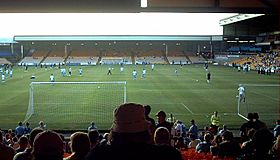
When Port Vale joined the English Football League in 1892, they were already playing at their fourth home ground. They started at the Meadows in Limekiln Lane, Longport. Then they moved to Westport Meadows in 1881, where they played for three years. This area often flooded, and today Westport Lake is where the ground used to be.
In 1884, the club moved to the Burslem Football and Athletic ground. They stayed there for only two years. This ground was near Burslem railway station, and the club took the area's name. The first match there was a 6–0 win over Everton in a friendly game. It also hosted FA Cup matches for the first time. However, it was not good enough.
Port Vale then moved to the Athletic Ground. This ground was across from the church on Waterloo Road, right on the Hanley and Burslem tram line. It was the club's home for 27 years, including twelve Football League seasons. It was called the Athletic Ground because it also hosted athletics events.
The Old Recreation Ground was Vale's home from 1913 to 1950. It was located in Hanley. Today, a multi-storey car park for the Potteries Shopping Centre stands where it used to be. The club faced tough financial times during World War II. They sold the ground to the council, who did not want to rent it back to the club. The club received £13,500 for the ground, which they needed to pay off a £3,000 debt.
Vale Park has been Port Vale's home ground since 1950. It is on Hamil Road, across from Burslem Park. It was originally planned to be a huge stadium, big enough for 80,000 people. It was even called the "Wembley of the North." However, the £50,000 project opened with a capacity of 40,000 (360 seated), which was still very ambitious. The capacity increased to a sold-out 49,768 for an FA Cup game against Aston Villa in 1960. The stadium was improved many times after Bill Bell became chairman in 1987. He wanted to make it "fit for the Premiership." Outside the ground are statues of Roy Sproson, who played 842 games for the club, and long-time manager John Rudge.
Rivalries and Supporters: Who Port Vale Plays Against
The club has a strong rivalry with Stoke City. Stoke City is based in the town of Stoke-upon-Trent. Stoke and Vale first played each other on December 2, 1882. They played a total of 44 Football League games until February 10, 2002, when they last met in the Second Division. Stoke won the first match 1–0, while Vale won the latest game 1–0.
Port Vale also has a strong rivalry with Crewe Alexandra. This rivalry became more important after Stoke was promoted to a higher league than Vale at the end of the 2001–02 season. A study in 2019 ranked the Port Vale-Stoke City rivalry as the joint-28th biggest in English professional football. The Port Vale-Crewe Alexandra game was ranked as the 14th biggest rivalry. Vale also has rivalries with Shrewsbury Town and Walsall. They have smaller rivalries with Burton Albion, Wolverhampton Wanderers, and Macclesfield Town.
The club's official matchday programme was voted the best in League Two in 2010–11. Supporters also created three unofficial fan magazines, called fanzines. The oldest were The Memoirs of Seth Bottomley, printed in the 1990s but now stopped, and the Vale Park Beano, which has been printed since 1997. The Beano got its name as a playful jab at Stoke's stadium, which was partly built with local council money. Derek I'm Gutted! is also a long-running fanzine, printed since August 2000. The name was inspired by a comment from then-manager Brian Horton to a local journalist after a defeat. The OneValeFan fansite is the largest independent Port Vale website and has been running since 1996. It was originally called There's only one Vale fan in Bristol? because the founder, Rob Fielding, lived in Bristol. The Ale and the Vale podcast won the Real EFL League One Podcast of the Year award in 2023.
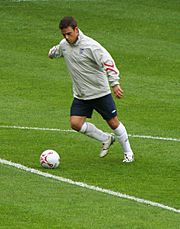
The club's most famous supporter is singer Robbie Williams, who grew up in Stoke-on-Trent. Before the club faced financial trouble in 2012, he was a major shareholder. He bought £240,000 worth of shares in the club in February 2006. Because of his investment, a restaurant at Vale Park is named after him. For the football game FIFA 2000, he provided an original theme song called "It's Only Us". He did this on the condition that Port Vale would be included in the game, which they were, in the "Rest of World" section. This song was also on the only FIFA Soundtrack CD released by EMI. In 2005, Williams started Los Angeles Vale F.C., a team in the United States. It was named after Port Vale and based at his L.A. home. His best friend, TV presenter Jonathan Wilkes, is also a Vale fan.
Another famous fan is darts legend Phil Taylor. Born in Burslem, "The Power" is a 16-time world champion in darts. The singer Simon Webbe was signed to the club's youth team as a teenager. However, a torn ligament at age 17 ended his football dreams. The children's illustrator and author Bob Wilson is also a fan. His Stanley Bagshaw book series is set in an area like Stoke. The main character supports a version of Vale, and one book is even based on their 1954 Cup run, but with a happy ending.
Club Records and Statistics
Port Vale's highest Football League finish was fifth place in the Football League Second Division (the second level) in 1930–31. Their best FA Cup finish was reaching the semi-finals in 1953–54. In the 2023–24 season, they reached the quarter-finals of the League Cup for the first time.
Port Vale's largest Football League victory was a 9–1 win over Chesterfield in the Second Division in 1932. Their heaviest loss was 10–0 to Sheffield United in 1892 in the same division. Other club record scores include a 16–0 victory over Middlewich in a friendly game in 1884. They also had a 12–0 defeat to Aston Villa in the Staffordshire Senior Cup in 1891.
The record for the most appearances for Port Vale is held by Roy Sproson, who played 842 matches in all competitions. Sproson also holds the record for the most league appearances for the club, with 760. His nephew, Phil Sproson, played 500 games in all competitions.
Wilf Kirkham is the club's top goalscorer with 164 goals in all competitions. This includes 153 in the league and 11 in the FA Cup. Kirkham's total of 41 goals in the 1926–27 season is also a club record. Tom Pope and Martin Foyle have also scored more than 100 goals for the club.
The first player to play for his country while playing for Vale was Teddy Peers. He made his debut for Wales. The player with the most international games is Chris Birchall. He played 27 times for Trinidad and Tobago while at the club. The first Vale player to score in an international match was Sammy Morgan. He scored for Northern Ireland against Spain on February 16, 1972.
The club's highest attendance at Vale Park was 49,768 against Aston Villa in the FA Cup on February 20, 1960. The lowest attendance was 554 against Middlesbrough U21 in the EFL Trophy on October 16, 2018.
The highest transfer fee received for a Vale player was £2,000,000 from Wimbledon for Gareth Ainsworth on October 29, 1998. Ainsworth was also the most expensive player bought by Vale, costing £500,000 from Lincoln City on September 11, 1997.
The youngest player to play for the club is Nelson Agho. He was 15 years and 262 days old on his first game against Walsall in the EFL Trophy on November 13, 2018. The oldest player is Tom Holford. He played his last match at 46 years and 68 days old against Derby County in the Second Division on April 5, 1924.
Players: Meet the Team
Current Squad
|
|
Women's Team
Port Vale Ladies was formed in 2017. They won the Staffordshire County League in their very first season. They reached the West Midlands Premier Division at the start of the 2024–25 season. The team's name changed to Port Vale F.C. Women at the end of the 2020–21 season. The women's section also has girls' teams for different age groups, from under-9 to under-16.
Club Management: Who Runs the Team
Boardroom and Backroom Staff
| Position | Name | Nationality |
|---|---|---|
| Manager: | Darren Moore | |
| Lead First-Team Coach: | Jamie Smith | |
| First-Team Coach: | Simon Ireland | |
| First-Team Coach: | Martin Devaney | |
| Goalkeeping Coach: | Gary Walsh | |
| Honorary Club Presidents: | John Rudge & Robbie Williams |
- Source
- Port Vale F.C.
Managerial History: Past Leaders
Tom Morgan was the first Port Vale manager to win a league title. He led them to the top of the Third Division North at the end of the 1929–30 season. Freddie Steele did the same in the 1953–54 season. He also took the club to the semi-finals of the FA Cup. He was followed by Norman Low, who led Vale to the Fourth Division title in 1958–59.
Gordon Lee (1969–70), John McGrath (1982–83), Micky Adams (2012–13), Darrell Clarke (2021–22), and Darren Moore (2024–25) also helped the team get promoted. John Rudge led the club to three promotions: 1985–86, 1988–89, and 1993–94. He also won the Football League Trophy in 1993. His successor, Brian Horton, also won the Football League Trophy final in 2001.
Honours: What Port Vale Has Won
League Titles
- Third Division North / Third Division / Second Division (level 3)
- Champions: 1929–30, 1953–54
- 2nd place promotion: 1993–94
- Play-off winners: 1989
- Fourth Division / League Two (level 4)
- Champions: 1958–59
- 2nd place promotion: 2024–25
- 3rd place promotion: 1982–83, 2012–13
- 4th place promotion: 1969–70, 1985–86
- Play-off winners: 2022
Cup Wins
- Football League Trophy
- Winners: 1992–93, 2000–01
See also
 In Spanish: Port Vale Football Club para niños
In Spanish: Port Vale Football Club para niños


